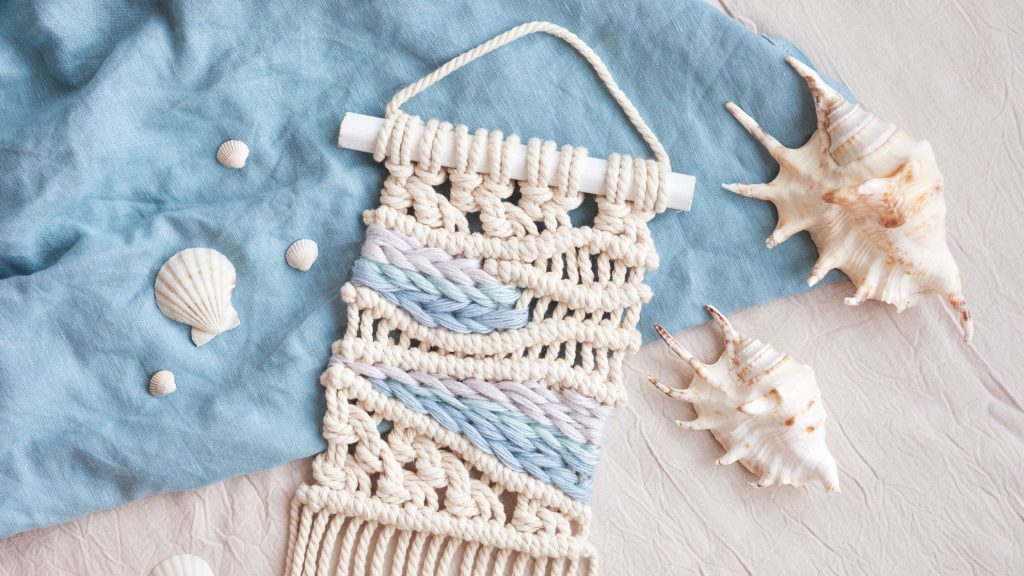Imagine being transported back in time to the era of maritime and naval exploration. As you navigate the vast seas, you will notice an unexpected yet significant art form that played a crucial role in these seafaring expeditions – macrame. While it may seem surprising, macrame, the intricate craft of knotting ropes, had a profound impact on maritime and naval history. Whether used for practical purposes or symbolizing a seafarer’s identity, macrame served as not just a decorative art form, but an essential part of life at sea. In this article, we will unravel the fascinating story of macrame’s place in the maritime and naval world.
Origins of Macrame
Ancient Macrame Techniques
Macrame, as an art form, dates back thousands of years. It originated in ancient times, with evidence suggesting its presence in several ancient civilizations, including the Egyptians, the Chinese, and the Babylonians. The exact origins of macrame remain somewhat unclear, as it was likely developed independently in different regions. However, regardless of its specific origins, macrame has undoubtedly played a significant role in maritime and naval history.
Spread of Macrame
The art of macrame gradually spread throughout the world over the centuries. As civilizations interacted through trade routes and maritime exploration, macrame techniques began to traverse different continents. It was through these interactions that sailors and seafarers became exposed to the intricate and versatile art form. Macrame’s popularity soared in maritime communities, and its influence quickly found its way onto ships.
Maritime Uses of Macrame
Sailors’ Practical Applications
Macrame had several practical applications in the maritime world, making it invaluable to sailors. One such use was creating nets for fishing and trapping. Macrame knots allowed for the creation of sturdy and functional nets that could withstand the rigors of the sea. These nets were essential for securing catches and providing sustenance to sailors during long journeys.
Furthermore, macrame was used to fashion hammocks that sailors would use for sleep on board. The intricate knotting techniques ensured that these hammocks were comfortable yet durable enough to withstand the turbulent movements of the ship.
Decorative Elements on Ships
In addition to its functional uses, macrame also found its way into the decorative elements of ships. Sailors would often create elaborate macrame designs to adorn various parts of the ship, such as the mast or the rigging. These decorative elements added a touch of beauty and craftsmanship to the ship, enhancing its aesthetic appeal.
Macrame was also used to create intricate window coverings and curtains on board. These delicate pieces not only provided privacy but also added a touch of elegance to the otherwise utilitarian living spaces of the sailors.
Macrame in Shipbuilding
Functional Macrame
Macrame was not limited to being a decorative art form in shipbuilding; it also played a functional role in the construction of ships. Sailors and shipbuilders would use macrame techniques to create strong and durable ropes, which were crucial for various aspects of shipbuilding. These ropes were used for rigging, securing sails, and even for hoisting heavy objects on board.
Macrame as Ship Decor
As shipbuilding evolved and ships became larger and more elaborate, macrame found its place as ship decor. Intricate macrame designs were incorporated into the ship’s interior, adorning walls, staircases, and even cabin furnishings. These decorative macrame pieces showcased the artistry and craftsmanship of sailors while creating a visually captivating environment.
Macrame in Nautical Knots
Macrame Knots in Navigation
Macrame knots were not solely limited to the decorative realm but also played a crucial role in navigation. Sailors used specific macrame knotting techniques to create knots that had various practical applications. For example, the bowline knot, a commonly used macrame knot, was utilized to secure ropes and lines firmly. This knot’s reliability and strength were vital in navigating and maneuvering the ship effectively.
Macrame in Seafarers’ Lives
Macrame knots were not only used for navigation purposes but also became intertwined with the daily lives of seafarers. Sailors would often create personal macrame pieces, such as bracelets or lanyards, using intricate knotting techniques. These personal creations served as mementos of their maritime adventures, fostering a sense of connection to the sea and their seafaring brethren.
Macrame in Navigation Tools
Macrame in Sextants
Sextants, an essential tool for celestial navigation, also incorporated macrame elements. The handles of sextants were often wrapped with macrame cords, providing sailors with a firm and comfortable grip. The intricate knotting not only served a functional purpose but also added an element of beauty to these navigational instruments.
Macrame in Astrolabes
Similarly, astrolabes, another ancient navigational instrument, also featured macrame embellishments. Macrame cords were attached to these instruments, allowing sailors to hang them conveniently around their necks. These intricate cord designs added charm to the astrolabes while ensuring that the instrument was always within reach for quick reference during navigation.
Macrame in Sailor’s Beliefs and Superstitions
Macrame Talismans
In the superstitious world of seafaring, macrame talismans held immense significance. Sailors believed that certain macrame knot designs possessed protective powers and could bring good fortune during their voyages. These intricate talismans were meticulously crafted and were often carried by sailors as a form of protection against the perils of the sea.
Macrame and Good Luck Charms
Macrame was also used to create various good luck charms for sailors. These charms, intricately woven using macrame techniques, were believed to ward off evil spirits and ensure a safe journey. Sailors would often hang these charms in their cabins or attach them to their clothes, relying on the power of macrame to bring them luck and safeguard their journeys.
Macrame in Seafarer’s Art and Crafts
Macrame in Sailor’s Crafts
Sailors, well-known for their artistic inclinations, embraced macrame as a form of creative expression. In their leisure time, they would engage in various crafts, such as knotting intricate macrame designs on small canvases or even carving wooden frames to showcase their macrame creations. These crafts allowed seafarers to nurture their artistic talents and create beautiful pieces that captured the essence of their life at sea.
Macrame Souvenirs
Sailors also used macrame techniques to create unique souvenirs that served as reminders of their maritime adventures. From intricately knotted keychains to delicate macrame jewelry, these souvenirs were treasured keepsakes or gifts for loved ones back home. The skill and precision required to create these macrame souvenirs showcased the creativity and dedication of sailors to their craft.
Macrame in Naval Uniforms
Macrame in Officer Ranks
In naval history, macrame played a significant role in distinguishing officer ranks through embellishments on their uniforms. Intricate macrame designs adorned the uniforms of naval officers, with different knotting patterns representing varying ranks. These decorative macrame elements not only added a touch of elegance to the uniforms but also symbolized the hierarchy and authority within the naval structure.
Macrame in Decorative Accents
Apart from the officer ranks, macrame also found its way into decorative accents on naval uniforms. Macrame cords and braids were used to enhance the aesthetics of various naval accessories, such as hats and epaulets. These decorative elements showcased the attention to detail and craftsmanship inherent in naval traditions.
Evolution of Macrame in Maritime Decor
Knotting Techniques in Sailors’ Crafts
As the centuries passed, macrame continued to evolve in maritime decor. Sailors’ crafts, once primarily focused on functional pieces, expanded to include more intricate and decorative macrame designs. Knotting techniques became more elaborate and complex, reflecting the evolving artistic sensibilities of seafarers. These crafts adorned ships with unique and visually stunning macrame displays, elevating the maritime decor to new heights.
Influence of Macrame in Nautical Interior Design
The influence of macrame in nautical interior design cannot be underestimated. In modern times, macrame continues to be incorporated into maritime-themed spaces, evoking a sense of nostalgia for the rich maritime history. From intricately knotted wall hangings to macrame-adorned furniture, the art form adds a distinct charm and a touch of the sea to nautical interiors.
Modern Applications of Macrame in Maritime
Macrame in Contemporary Naval Crafts
In the contemporary maritime world, macrame continues to be relevant and influential. Modern naval crafts, such as sailboats and yachts, often incorporate macrame elements in their design. Knots and macrame patterns are skillfully woven into the rigging and sails, adding a touch of tradition and artistry to these seafaring vessels.
Macrame in Nautical Fashion
Furthermore, macrame has also made its mark in nautical fashion. Designers draw inspiration from maritime traditions, incorporating macrame elements into clothing and accessories. Delicate macrame lacework, reminiscent of sailors’ knotting techniques, adorns dresses, swimwear, and even handbags, creating fashionable pieces that pay homage to the rich macrame heritage in maritime history.
Conclusion
In conclusion, the role of macrame in maritime and naval history is multifaceted and far-reaching. From practical applications in fishing nets and shipbuilding to decorative elements and navigational tools, macrame has weaved its way into the fabric of seafaring traditions. Its influence can be seen not only in sailors’ beliefs, art, and crafts but also in contemporary naval crafts and fashion. As we continue to navigate the waters of history, macrame remains an enduring symbol of the enduring bond between the sea and those who sail upon it.


















